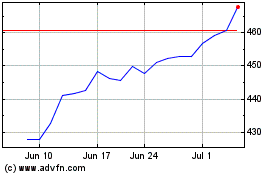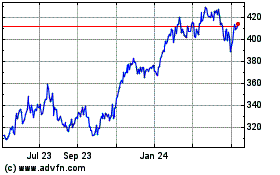By Angus Loten
Companies are turning to robot speech coaches and slideshow
designers to give meetings more pizazz.
The tools, including an artificial-intelligence-powered
presentation coach launched this week by Microsoft Corp., are part
of a fast-growing market for digital assistants designed to ease
everyday office tasks, such as handling invoices and expense
reports.
"Putting a presentation together takes work," said Eleni
Kelakos, president of the Eleni Group, a presentation coaching firm
based in Ann Arbor, Mich. But most people leave public-speaking
prep to the last minute, she said, raising the risk of "weaker
presentations and diminished confidence."
Unprepared or nervous speakers tend to talk too fast or in a
slow monotone, lose their train of thought, or rely too heavily on
jargon or information already conveyed in slides, said Stacey
Shipman, a public speaking coach and facilitator at
Massachusetts-based company Engage the Room. That can lead to
colleagues or customers staring at their phones during meetings,
she said.
Kirk Koenigsbauer, corporate vice president in Microsoft's
Office division, said its digital presentation coach is designed to
tackle these and other issues.
As the user rehearses a presentation by speaking into a desktop,
laptop or smartphone microphone, the new tool can provide real-time
feedback on pacing, word choice, language tics such as "um" and
"anyway." When the speaker is finished, it generates an instant
report suggesting areas for improvement.
"It's listening to speech and analyzing the words," using
AI-powered voice-recognition software to convert speech to text and
search a database of flagged terms and best practices, Mr.
Koenigsbauer said. The database is fine-tuned as users revise or
ignore the tool's suggestions, he added.
Other features in Microsoft's suite of business apps, such as
slideshow, spreadsheet and videoconferencing tools, include AI
components to help presenters convey complex business data visually
-- and grab the attention of their listeners, Mr. Koenigsbauer
said.
The sheer amount of that data can present its own problems.
Vijay Khanna, chief corporate development officer at robotic
software maker UiPath Inc., said preparing for meetings today
involves logging into various systems, copying and pasting numbers
into a centralized repository, and generating figures to visualize
cobbled-together data. "This can be incredibly tedious and manual
work," he said.
Mr. Khanna said robotic process automation can perform such
tasks more quickly and with fewer errors, freeing up time for
workers to focus on insights that drive business decisions.
"One of the key pain points is turning data into a
human-friendly narrative, suitable for normal people," said Colin
Priest, vice president of AI strategy at DataRobot Inc., a
technology firm that develops software applications that help
translate complex AI-generated data into information that
business-side executives can understand and act on.
Many business executives don't know how to interpret numeric
results, Mr. Priest said. At the same time, many tech workers
struggle to explain data in nontechnical terms, making for
drawn-out meetings with little or no value for corporate decision
makers, he added.
Likewise, Amy Chang, senior vice president of Cisco Systems
Inc.'s collaboration technology group, said the company in recent
years introduced smart technology to help meetings be more engaging
and productive.
This includes tools that can identify meeting attendees through
AI-enabled facial-recognition capabilities, automatically scour the
internet for biographical information and instantly convey it to
the meeting host by email or text. The goal is to give the
presenter a "better sense of the room," Ms. Chang said.
Cisco has developed other digital assistants designed to take
over mundane tasks associated with meetings. They include robotic
software apps that can take notes, add items to corporate calendars
as they come up, and track down follow-up contact information with
other meeting attendees, among other routine jobs that used to be
left to an office assistant.
Many of these capabilities fall under the broader scope of
digital workplace efforts, a strategy underpinned by smart tools
and robotic process automation technology that seeks to automate
manual office tasks.
Global spending on these efforts climbed to $680 million last
year, up 57% from 2017, and it is on pace to reach $2.4 billion by
2022, according to enterprise tech research firm Gartner Inc. It
estimates that roughly 60% of companies world-wide with more than
$1 billion in annual revenue are using some form of the technology,
and more than 80% will adopt it within the next three years.
"Most enterprises are in the early innings of their automation
journeys, " Mr. Khanna said. But over the next five years, he
added, "it won't be about simple, repetitive tasks anymore, but
rather about using automation to better understand and optimize the
business processes," including daily meetings.
Write to Angus Loten at angus.loten@wsj.com
(END) Dow Jones Newswires
September 26, 2019 18:20 ET (22:20 GMT)
Copyright (c) 2019 Dow Jones & Company, Inc.
Microsoft (NASDAQ:MSFT)
Historical Stock Chart
From Mar 2024 to Apr 2024

Microsoft (NASDAQ:MSFT)
Historical Stock Chart
From Apr 2023 to Apr 2024
